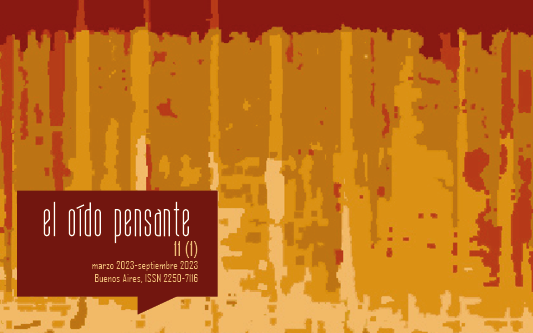Sound Manipulation and Influences on Youth Music Consumption
Abstract
In a context of growing concern regarding the trafficking of private information on the networks, the manipulation of the individual, and the violation of people's freedom of decision, this research focuses its attention on the possible homogenization mechanisms present in the music of mass consumption aimed at the youth and adolescent public. For that purpose, a phenomenological descriptive study is proposed, through a series of interviews, where the testimony of record producers specialized in said music is used. The results show the existence of certain musical production practices, strictly regulated and at the service of the record industry, which exert a marked influence on the perception, assimilation and consumption of mass music. In this way, techniques for recording and for sound post-production with expressive capacity are described, which can regulate the emotions of the listeners and reinforce imageries, ideologies and attitudes through recorded music. Also, the way is understood in which the use of these patterns of sound manipulation directly affects the musical preferences of the listeners and contributes to a worrying drift towards cultural homogenization among young people in our society.Downloads
References
Abril, C. (2007). “Functions of a National Anthem in Society and Education: A Sociocultural Perspective”. Bulletin of the Council for research in Music Education 172, 1-19. Doi: https://doi.org/10.1080/00031305.2019.1583913
Adorno, T. y Horkheimer, M. (1972). Dialectic of Enlightement. New York: Herder y Herder.
Arnheim, R. (2005). Arte y percepción visual: psicología del ojo creador. Madrid: Alianza.
Attali, J. (1977) Bruits. París: PUF.
Bennett, H. S. (1980). On Becoming a Rock Musician. Amherst: University of Massachusetts Press.
Burgess, R. J. (2013). The Art of Music Production: The Theory and Practice. Oxford: Oxford University Press.
Cleveland, B. (2001). Creative Music Production: Joe Meek's Bold Techniques. Nashville: Artistpro.
Couldry, N. y Hepp, A. (2017). The mediated construction of reality. Cambridge: Polity.
Danielsen, A. (2017). “Music, Media and Technological Creativity in the Digital Age”. Nordic Research in Music Education 18, 9-22. Doi: http://hdl.handle.net/11250/2490532
Deruty, E. y Tardieu, D. (2014). “About Dynamic Processing in Mainstream Music”. Journal of the Audio Engineering Society 62, 42-55. Doi: http://dx.doi.org/10.17743/jaes.2014.0001
Devine, K. (2013). “Imperfect Sound Forever: Loudness Wars, Listening Formations and the History of Sound Reproduction”. Popular Music 32(2), 159-176. Doi: https://doi.org/10.1017/S0261143013000032
Duffett, R. G. (2017). “Influence of Social Media Marketing Communications on Young Consumers’ Attitudes”. Young Consumers 18(1), 19-39. Doi: https://doi.org/10.1108/YC-07-2016-00622
Faure-Carvallo, A. (2019). Modelos Sonoros y Preferencias Musicales en la Adolescencia. Un estudio en el área urbana de Barcelona. (tesis de Ph.D.). Universitat de Barcelona, Barcelona, España. Recuperado de: http://hdl.handle.net/10803/669946
Faure-Carvallo, A., Calderón-Garrido, D. y Gustems-Carnicer, J. (2020). Modelos sonoros en la adolescencia: Preferencias musicales, identidades e industria discográfica. Revista Música Hodie, 20. Doi: https://doi.org/10.5216/mh.v20.63134
Faure-Carvallo, A., Gustems-Carnicer, J. y Navarro, M. (2020). Producción musical y mercado discográfico: homogeneización entre adolescentes y reto para la educación. Revista Electrónica de LEEME, (45), 69-87. Doi: https://doi.org/10.7203/LEEME.45.16625
Field, M. (2020). “The Best Music Streaming Services: Apple Music, Spotify, YouTube Music and Amazon Music Compared”. The Telegraph 30(4). Recuperado de: https://www.telegraph.co.uk/technology/0/best-music-streaming-services-apple-music-spotify-amazon-music/
Giroux, H. A. (2011). “How Disney Magic and the Corporate Media Shape Youth Identity in the Digital Age”. Truthout 21(8). Recuperado de: https://truthout.org/articles/how-disney-magic-and-the-corporate-media-shape-youth-identity-in-the-digital-age/
Gunster, S. (2004). Capitalizing on Culture: Critical Theory for Cultural Studies. Toronto: University of Toronto Press.
Harper, A. (2014). Lo-Fi Aesthetics in Popular Music Discourse. (tesis de Ph.D.). Wadham College, University of Oxford, Oxford, Inglaterra.
Herrera, L., Cremades, R., y Lorenzo, O. (2010). Preferencias musicales de los estudiantes de Educación Secundaria Obligatoria: influencia de la educación formal e informal. Cultura y educación 22(1), 37-51. Doi: https://doi.org/10.1174/113564010790935222
Hinz, L. (2018). “What does “Selling out” Mean in the Digital Age?” Hot New Hip Hop 22(9). Recuperado de: https://www.hotnewhiphop.com/what-does-selling-out-mean-in-the-digital-age-news.62471.html
Hormigos, J. (2010). “La creación de identidades culturales a través del sonido”. Comunicar XVII(34), 91-98. Doi: https://doi.org/10.3916/C34-2010-02-09
Juan de Dios Cuartas, M. A. (2016). “La producción musical como objeto de estudio musicológico: un acercamiento metodológico a su análisis”. Cuadernos de etnomusicología 8, 20-47. Recuperado de: https://www.researchgate.net/publication/320259084_La_produccion_musical_como_objeto_de_estudio_musicologico_un_acercamiento_metodologico_a_su_analisis
Juslin, P. N. y Laukka, P. (2004). “Expression, Perception, and Induction of Musical Emotions”. Journal of new Music Research 33(3), 217-238. Doi: https://doi.org/10.1080/0929821042000317813
Katz, B. (2002). La masterización de audio. El arte y la ciencia. Andoain: Escuela de cine y vídeo.
Linn, S. (2004). Consuming Kids. New York: The New Press.
Llopis Goig, R. (2014). La cultura en la época del capitalismo cultural. Tendencias y controversias. Culturas. Revista de Gestión Cultural 1(1), 46-60. Doi: https://doi.org/10.4995/cs.2014.3180
Martin, G., y Hornsby, J. (1994). All You Need Is Ears: The inside personal story of the genius who created the Beatles. Macmillan.
Martínez, R. A. (2007). La investigación en la práctica educativa: Guía metodológica de investigación para el diagnóstico y evaluación en los centros docentes. Madrid: Ministerio de Educación y Ciencia/CIDE.
Massot, I., Dorio, I. y Sabariego, M. (2004). “Estrategias de recogida y análisis de la información”. En Metodología de la investigación educativa, (329-366) Madrid: La Muralla.
Mendívil, J. (2016). En contra de la música: herramientas para pensar, comprender y vivir las músicas. Buenos Aires: Gourmet Musical.
Merriam, A. (1964). The Anthropology of Music. Chicago: Northwestern University Press.
Middleton, R. (1990). Studying Popular Music. Philadelphia: Open University Press.
Milner, G. (2016). El Sonido y la Perfección, una historia de la música grabada. Madrid: Lovemonk/Léeme Libros.
Minor, E. C., Saw, G. K., Frank, K. A., Schneider, B. y Torphy, K. (2019). “External Contextual Factors and Teacher Turnover: The Case of Michigan High Schools”. Teachers College Record 121(11), 1-30. Recuperado de: https://eric.ed.gov/?id=EJ1261809
Negus, K. (2005). Los géneros musicales y la cultura de las multinacionales. Barcelona: Paidós.
North, A. y Hargreaves, D. (2007). “Lifestyle Correlates of Musical Preference”. Society for Education, Music and Psychology Research 35(1), 58-87. Doi: https://doi.org/10.1177/0305735607068888
O’Neil, C. (2018). Armas de destrucción matemática. Madrid: Capitán Swing.
Perona, J. J., Barbeito, M. y Fajula, A. (2014). “Los jóvenes ante la sono-esfera digital: medios, dispositivos y hábitos de consumo sonoro”. Comunicación y Sociedad 1(27), 205-224. Doi: https://doi.org/10.15581/003.27.1.205-224
Polo Pujadas, M. (2020). Historia de la música. Santander: Editorial de la Universidad de Cantabria.
Porta, A. y Ferrández, R. (2009). “Elaboración de un instrumento para conocer las características de la banda sonora de la programación infantil de televisión”. RELIEVE 15(2), 1-18. Recuperdao de: http://hdl.handle.net/10234/25544
Postman, N. (1994). The Disappearance of Childhood. New York: Vintage.
Pouivet, R. (2010). Philosofie du Rock; Une ontologie des artefacts et des enregistrements. París: Presses universitaires de France.
Randall, D. (2018). Sound System: el poder político de la música. Pamplona: Katakrak Liburuak.
Ribowsky, M. (2000). He's a Rebel: Phil Spector. Rock and Roll's Legendary Producer. Nueva York: Cooper Square Press.
Rotondi, J. (2011). The Enduring Legacy of SSL. Universal Audio. Universal Audio (web). Recuperado de: https://www.uaudio.fr/blog/the-enduring-legacy-of-ssl/
Ruiz Bueno, A. (2014). Las formas de interrogación: La Entrevista. Diposit Digital de la Universitat de Barcelona (repositorio institucional). Recuperado de: http://diposit.ub.edu/dspace/handle/2445/51024
Schafer, R. M. (2013). El paisaje sonoro y la afinación del mundo. Barcelona: Intermedio.
Schedl, M., Zamani, H., Chen, Ch., Deldjoo, Y. y Elahi, M. (2018). “Current Challenges and Visions in Music Recommender Systems Research”. International Journal of Multimedia Information Retrieval 7(2), 95-116. Doi: https://doi.org/10.1007/s13735-018-0154-2
Terrazas-Bañales, F, Lorenzo, O. y González-Moreno, P. (2013). “Consumo musical de estudiantes universitarios de México. Una comparación entre alumnos de distintas facultades de una universidad mexicana”. Revista electrónica de LEEME 32. Recuperado de: https://ojs.uv.es/index.php/LEEME/article/view/9853
Tunstall, J. (1977). The Media are American. Columbia University Press.
Universitat de Barcelona. (2010). Código de buenas prácticas en investigación. Barcelona: Edicions de la Universitat de Barcelona.
Webster, J. G. (2017). Three Myths of Digital Media. Convergence 23(4): 352-361. Doi: https://doi.org/10.1177/1354856517700385
Zagorski-Thomas, S. (2014). The Musicology of Record Production. Cambridge: Cambridge University Press.
Zarouali, B., Ponnet, K., Walrave, M. y Poels, K. (2017). Do you Like Cookies? Adolescents' Skeptical Processing of Retargeted Facebook-ads and the Moderating Role of Privacy Concern and a Textual Debriefing. Computers in Human Behavior 69, 157-165. Doi: https://doi.org/10.1016/j.chb.2016.11.050























